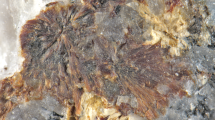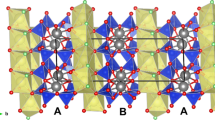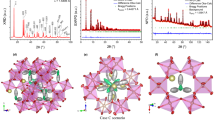Abstract
INFRA-RED spectroscopy has been found to be a useful method in establishing the orientation of OH bonds in layer silicates1. In micas and related forms of crystallization, the orientation of the OH depends on the occupancy of the octahedral positions. In trioctahedral compositions, the OH bonds are normal to the flakes and these groups are free of association in any supplemental bond (absorption band at 3,700 cm.−1). In dioctahedral minerals, the OH are inclined about 20° to the plane of the flakes and directed to the unoccupied octahedra; the absorption band is observed at 3,620 cm.−1, which indicates some degree of secondary association.
This is a preview of subscription content, access via your institution
Access options
Subscribe to this journal
Receive 51 print issues and online access
$199.00 per year
only $3.90 per issue
Buy this article
- Purchase on Springer Link
- Instant access to full article PDF
Prices may be subject to local taxes which are calculated during checkout
Similar content being viewed by others
References
Serratosa, J. M., and Bradley, W. F., J. Phys. Chem., 62, 1164 (1958).
Romo, L., J. Phys. Chem., 60, 987 (1956).
Newnham, R. E., Min. Mag., 32, 683 (1961).
Fripiat, J. J., and Toussaint, F., Nature, 186, 627 (1960).
Author information
Authors and Affiliations
Rights and permissions
About this article
Cite this article
SERRATOSA, J., HIDALGO, A. & VINAS, J. Orientation of OH Bonds in Kaolinite. Nature 195, 486–487 (1962). https://doi.org/10.1038/195486a0
Issue Date:
DOI: https://doi.org/10.1038/195486a0
This article is cited by
-
Characterization and morphology of spray dried kaolin particles
Brazilian Journal of Chemical Engineering (2021)
-
State of the structural hydroxyl groups in minerals of the kaolinite group according to infrared spectroscopic data
Theoretical and Experimental Chemistry (1985)
-
Infra-red Investigation of the OH Bonds in Chlorites
Nature (1964)
Comments
By submitting a comment you agree to abide by our Terms and Community Guidelines. If you find something abusive or that does not comply with our terms or guidelines please flag it as inappropriate.



